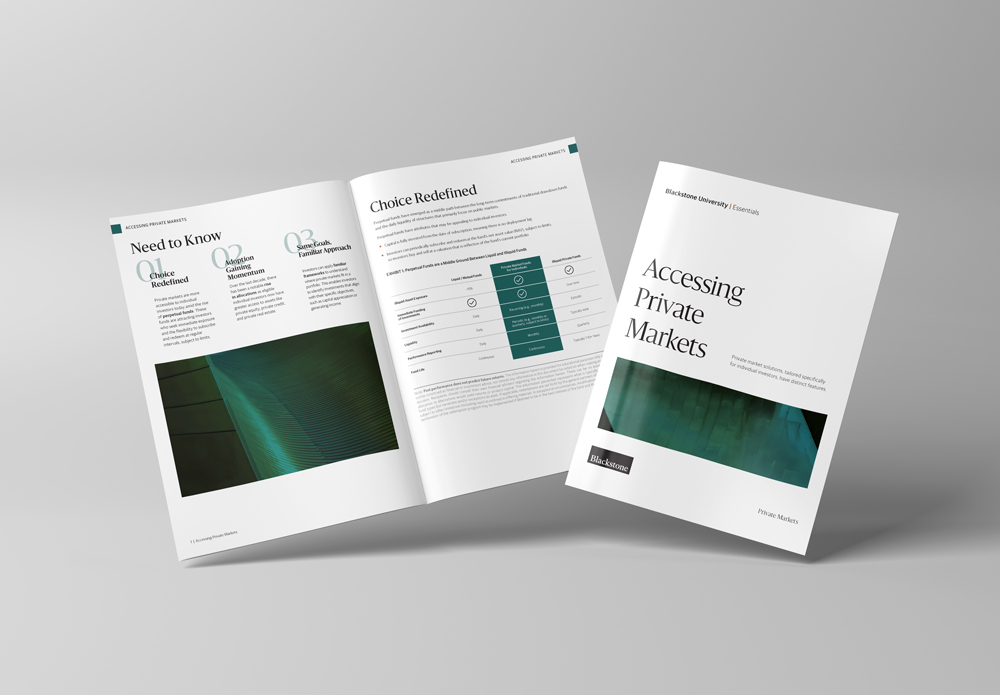
Accessing Private Markets
Download the full brochure
What You Need to Know
Choice Redefined
Private markets are more accessible to individual investors today amid the rise of perpetual funds. These funds are attracting investors who seek immediate exposure and the flexibility to subscribe and redeem at regular intervals, subject to limits.
Adoption Gaining Momentum
Over the last decade, there has been a notable rise in allocations as eligible individual investors now have greater access to assets like private equity, private credit, and private real estate.
Same Goals, Familiar Approach
Investors can apply familiar frameworks to understand where private markets fit in a portfolio. This enables investors to identify investments that align with their specific objectives, such as seeking capital appreciation or generating income.
Choice Redefined
Perpetual funds have emerged as a middle path between the long-term commitments of traditional drawdown funds and the daily liquidity of structures that primarily focus on public markets.
Perpetual funds have attributes that may be appealing to individual investors:
- Capital is fully invested from the date of subscription, meaning there is no deployment lag
- Investors can periodically subscribe and redeem at the fund’s net asset value (NAV), subject to limits, so investors buy and sell at a valuation that is reflective of the fund’s current portfolio
Exhibit 1: Perpetual Funds are a Middle Ground Between Liquid and Illiquid Funds
Note: Past performance does not predict future returns. The information herein is provided for educational purposes only and should not be construed as financial or investment advice, nor should any information in this document be relied on when making an investment decision. Recipients should consult their own financial advisers regarding the information herein. There can be no assurance that an allocation to alternatives would yield returns or protect capital. The information presented represents what is typically seen for these fund types but variations and/or exceptions do exist. If applicable, redemptions are set forth by the general partners of the fund and are subject to other limitations (including caps) as outlined in offering materials. In exceptional circumstances, modifications, suspensions and termination of the redemption program may be implemented if deemed to be in the best interest of the fund and the fund’s investors.
The Power of Compounding
Exhibit 2: Illustrative Cumulative Value & Timing of Cash Flows for Scenario 2
(Cumulative Contributions / Distributions)1
Distributions are not guaranteed.
One of the key innovations of perpetual funds is their ability to provide immediate investment in private and illiquid assets. Unlike drawdown funds, which gradually call capital and acquire assets over time, perpetual funds put capital to work immediately, allowing investors to harness the power of compounding right away (Exhibit 2).
Across a range of scenarios (Exhibit 3), the ability to harness compounding can result in a higher multiple over time.
Drawdown funds are useful for investors seeking exposure to a specific strategy or asset class and for those who are willing to trade committing capital for longer periods for potentially higher returns.
*To achieve the multiples displayed above, contributions to the drawdown fund generate the corresponding net IRR. It is assumed that undrawn capital and distributions are invested in a portfolio of US Treasury Bonds, generating a 5.0% return.
Exhibit 3: Relationship between Multiples and Net Returns Under Different Return Scenarios1
Note: Target returns are hypothetical in nature and are shown for illustrative, informational purposes only. This material is not intended to forecast or predict future events, but rather to indicate the returns for the asset classes listed above that Blackstone has observed in the market generally. It does not reflect the actual or expected returns of any portfolio strategy and does not guarantee future results. The target returns are based upon Blackstone’s view of the potential returns for investments of the strategy discussed herein, are not meant to predict the returns for any accounts managed by Blackstone and are subject to certain assumptions. There is no guarantee that Blackstone products will achieve their investment objectives. The opinions expressed herein reflect the current opinions of Blackstone and should not be construed as research or investment advice. Investors should consult their own legal, accounting and tax advisers to make an independent determination of the suitability and consequences of an investment. Please refer to footnote 1 for calculation methodology.
Adoption Gaining Momentum
Exhibit 4: 10-Year AUM Growth in Perpetual Funds for Individual Investors in the U.S. Total Assets
($ in billions)
Individual investors are markedly under-allocated to private markets, especially when compared to sophisticated investors such as endowments who have used alternative investments for decades.2 This is changing, however, partly due to the evolution of fund structures.
Allocations to the most widely owned types of perpetual funds for individuals have soared over the last decade.3
Looking ahead, analysts project allocations to these strategies from individual investors to nearly double by 2027 and triple over the next eight years.4
Same Goals, Familiar Approach
Investors can pursue specific objectives using private markets, such as capital appreciation, income generation, diversification, inflation protection, and tax advantages. Introducing private markets in this way can help individual investors understand where these assets fit into a portfolio to pursue specific goals.
There can be no assurance that capital will appreciate. There can be no assurance that any Blackstone fund or investment will achieve its objectives or avoid substantial losses. There is no assurance that any Blackstone fund or product will effectively hedge inflation. Diversification does not ensure a profit or protect against losses.
Read the complete
Accessing Private Markets


Essentials of Private Markets
Learn how assets such as private real estate, credit and equity can fit into investment portfolios.
- Net Internal Rate of Return (IRR) is utilized to express traditional drawdown fund returns due to its effectiveness in capturing the time value of money and the performance of investments with incremental cash flows and periodic distributions. For perpetual funds, which generally do not have capital calls and distributions, Net Annualized Returns are used as they provide a clearer picture of the ongoing, compounded returns investors can expect over time. This material is not intended to forecast or predict future events, but rather to indicate the returns for the asset classes listed above that Blackstone has observed in the market generally. It does not reflect the actual or expected returns of any portfolio strategy and does not guarantee future results. The target returns are based upon Blackstone’s view of the potential returns for investments of the strategy discussed herein, are not meant to predict the returns for any accounts managed by Blackstone and are subject to certain assumptions. There is no guarantee that Blackstone products will achieve their investment objectives. For the perpetual vehicle, we assume that all capital is deployed in Year 1 and the vehicle is fully invested into private equity assets immediately and that all capital gains are reinvested into the vehicle. Returns for the traditional drawdown vehicle assumes a committed management fee rate (1.25%), an invested management fee rate (1.25%), carry percentage (20.0%), and LP preferred return (8.0%). The perpetual returns assumes a management fee rate (1.25%) and incentive fee (12.5%). Multiples assumes 9‐year term for the traditional drawdown vehicle and 10-year term for the perpetual vehicle. The modeled traditional drawdown vehicle assumes that 90% of available capital is deployed in equal increments over a 4‐year investment period (Year 2 to Year 5), an average holding period of 5 years for investments, and returns are distributed in equal increments over a 4-year period (Year 7 to Year 10) to the LP. For the multiple calculation of the traditional drawdown vehicle, it is assumed that uncalled but committed capital is invested in a portfolio of US Treasury Bonds, generating a 5.0% return. This assumption facilitates the comparison of multiples across different structures, contrasting with a perpetual fund where 100% of an investor’s capital is invested immediately on day one.
- National Association of College and University Business Officers, “2023 NACUBO-TIAA Study of Endowments,” 2023; For Individual Investors, Bain & Company, “Global Private Equity Report,” 2023. For Endowments, the alternative asset allocation is for the Public College, University or System only and represented by allocations to Alternative Strategies (includes marketable alternatives (hedge funds), private equity, private venture capital, and real assets).
- Source: Blue Vault, Interval Fund Tracker, Cerulli Associates, 2023. Funds tracked are interval funds, non-traded real estate investment trusts, non-traded business development companies, and tender offer funds. Figures based on gross asset value for non-traded real estate investment trusts and non-traded business development companies, and net asset value for interval and tender offer funds.
- Market size / share estimated by utilizing two sources: (1) Bain & Company, “Global Private Equity Report 2023” and (2) OliverWyman, “Asset and Wealth Management Report 2023.”
